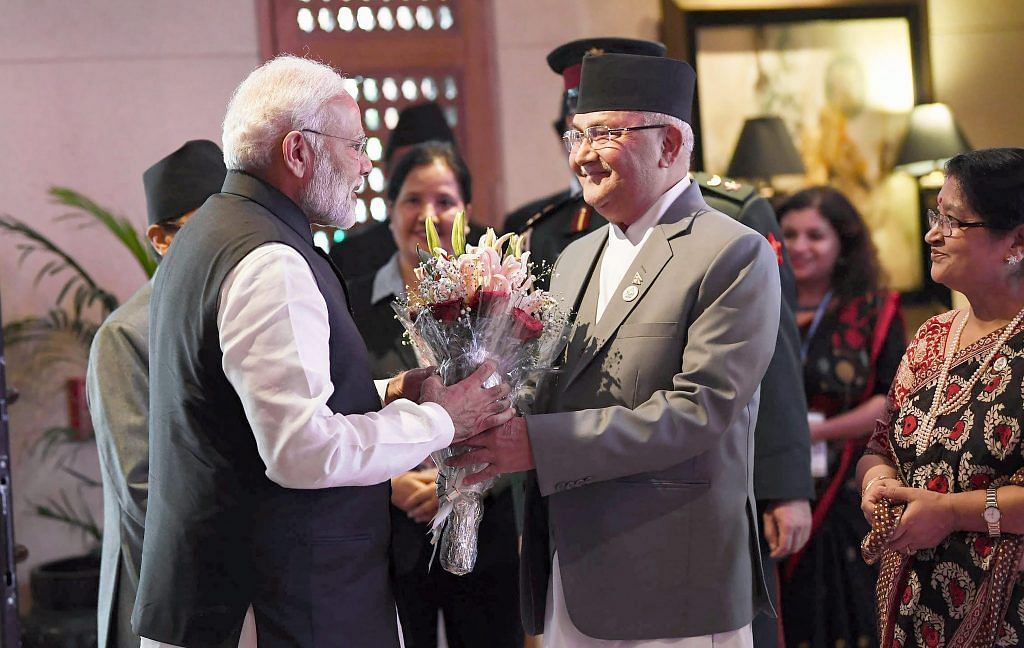New Delhi: The Narendra Modi government has refused to meet Nepal Prime Minister K.P. Sharma Oli’s special envoy Madhav Kumar Nepal, who was expected to arrive on a trip to New Delhi earlier this week to discuss the contentious issue of Kalapani.
Kalapani is a 35 square kilometre area, which is claimed by both India and Nepal as an integral part of their territories — India as part of Uttarakhand’s Pithoragarh district and Nepal as part of its Darchula district.
Madhav Kumar Nepal, the former PM of the landlocked country and senior leader of the Nepal Communist Party, was expected to visit India to discuss the latest row between New Delhi and Kathmandu over Kalapani, sources told ThePrint.
Nepal was planning to visit New Delhi between 4-5 December and wanted to meet Prime Minister Narendra Modi to urge him to “immediately establish” a foreign secretary-level dialogue mechanism to settle the border dispute, the sources said.
But, they added, the Indian government refused to meet the special envoy.
Nepal eventually cancelled his plan to come to India.
Nepal’s Foreign Minister Pradeep Gyawali said Thursday it has not yet received any response from the Indian side on their request to meet Indian officials.
The high-level dialogue mechanism, consisting of foreign secretaries of both the countries, to settle Kalapani and other issues was finalised by former and late external affairs minister Sushma Swaraj during her visit to Nepal in July 2014.
However, despite a subsequent visit by PM Modi to Nepal in August in the same year, the mechanism was never put in place, though he gave a renewed push to settle the Kalapani and Susta boundary disputes.
The present dispensation in Nepal has come under massive pressure from the opposition parties to take a firm stand against India over the unsettled issue of Kalapani as well as Susta, which are on the country’s western and eastern borders, respectively.
Ever since India released a new map on 2 November this year, there has been a spate of protests in Nepal over New Delhi’s move to show Kalapani as part of India. Nepalese students, affiliated with opposition party Nepali Congress, were seen burning the new map in front of the Indian Embassy in Kathmandu.
The sources also said the “invisible hand of Beijing” cannot be ruled out in the entire controversy as Kalapani also borders Tibet and, therefore, China is closely monitoring the developments.
Nepal is also part of the mega ‘Belt and Road Initiative’ (BRI), under which China is planning to build a massive trans-Himalayan railway network in Nepal connecting both the countries.
“If India can solve the boundary issue with Bangladesh, which also included a maritime boundary, then why not with Nepal, with which we have a special and friendly relationship. We have given Bangladesh much more than they needed, then why let the issue fester with Nepal,” asked Jayant Prasad, veteran diplomat and former Indian ambassador to Nepal.
He said he doesn’t see any reason for the Indian government to not solve the border issues. “This (India’s delay in discussing the matter) will only help those who are inimical to India-Nepal friendly ties,” added Prasad.
Also read: India only cares about national interest. And Nepal has been at the receiving end of it
Kalapani adds to deteriorating bilateral ties
The issue of Kalapani and Susta continue to sour the ties between the two neighbours, which have been “drastically declining” since the Madhesi agitation, according to the sources.
Madhesis, mostly of Indian-origin, launched an agitation between September 2015 and February 2016 against the implementation of the new Constitution, which they felt marginalised the Terai community.
Thus, while New Delhi has been pushing Kathmandu to sign the border agreement at the diplomatic level, the Oli government has refused to do so, which has irked India because it believes Nepal still has questions on it, the sources said.
“India has asked Nepal many times to sign the initial agreement, but they have refused to do so. There is an established mechanism at the level of foreign secretary that can be activated in which this issue and other outstanding issues can be resolved,” said Ranjit Rae, who was India’s ambassador to Nepal from 2013 to 2017.
Last month, Ambassador of Nepal to India Nilamber Acharya met Foreign Secretary Vijay Gokhale and handed over a document on how the Oli administration views the Kalapani issue. He had also requested an urgent meeting to be convened on the matter.
The main difference between India and Nepal over the Kalapani issue is regarding the source of Mahakali river. While New Delhi believes the river originates from Kalapani, which is in Uttarakhand, Nepal says the source is Lipulekh, a Himalayan pass near a trijunction point between India, Nepal and China.
As part of the 1816 Treaty of Sugauli, the British had demarcated the river in Nepal’s western border.
(Edited by Debalina Dey)
Also read: How a wildlife conservation pact between India and Nepal can boost their bilateral ties
